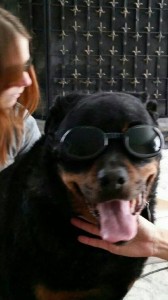 I’ve mentioned laser therapy before here, once or twice, as one of the treatment options that we offer as part of our palliative care and pain control arsenal, but I’ve never had the chance to go into detail about exactly what it is, how it works, or what it’s used for. So I’m going to take a little time right now to do just that.
I’ve mentioned laser therapy before here, once or twice, as one of the treatment options that we offer as part of our palliative care and pain control arsenal, but I’ve never had the chance to go into detail about exactly what it is, how it works, or what it’s used for. So I’m going to take a little time right now to do just that.
Therapeutic laser is, essentially, using a concentrated application of particular wavelengths of light to aid tissue healing and pain control and to decrease inflammation. The wavelengths of light that this particular laser produces are absorbed by parts of the cell called chromophores, leading to increases in cellular metabolism.
This causes the tissues being treated to produce compounds that provide local pain control, including endorphins. It also decreases pain by helping inflamed or irritated nerves return to normal function. In addition, laser treatment improves circulation, decreases the production of inflammatory compounds, and stimulates tissue healing.
What sort of conditions can laser be used to treat? Just about anything that causes symptoms related to pain, injury, or inflammation. In a hospice setting, it’s particularly useful as part of a protocol to help control pain from arthritis and acute or chronic joint injuries. It’s also very helpful for wound treatment, for patients dealing with bed sores, non-healing wounds, or skin infections.
What does laser treatment involve? Thankfully, for the patient, it’s very simple and pain-free. Everyone involved – both people and pets – does need to wear eye protection (while the laser we use is safe and painless, it’s always important to protect your eyes whenever working with lasers!); luckily, your vet will be able to provide these for you. The patient can sit, stand, or lie down in a comfortable position, and your veterinarian will gently move the laser handpiece over the area being treated. Sometimes, when we’re treating a joint, we may slowly move that join back and forth if it’s not painful to the pet to do so – this is called “passive range of motion exercise.” Depending on the size of the animal and the condition being treated, a laser session may last anywhere from 5-20 minutes.
For many conditions, especially chronic pain or injuries, several treatments may be required before a response is seen. At Autumn Care & Crossings, we recommend a starting treatment plan of six sessions over the first 2-3 weeks for most patients, with further treatment based on their individual response. Some patients heal and can then stop treatment; others move onto a less-frequent maintenance plan as we continue to manage their comfort long-term.
In my opinion, the most important detail about laser treatment, and the thing that makes it most useful for many older patients, is the fact that it has no systemic side effects and is safe to use with other medications. For animals that may be on multiple medications for other illnesses, or may have conditions that make systemic medications unsafe, laser provides a safe and comfortable way to treat pain that may otherwise go unmanaged. This also makes it excellent to use in combination with oral pain medications, nutritional supplements, and other pain management techniques.
Ultimately, it’s one of the many tools in our arsenal for helping your pet stay comfortable and happy as they face the challenges of aging!
